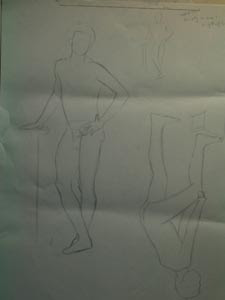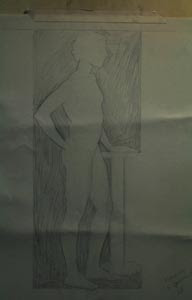One goal of some 2-dimensional artists is to try to create the illusion of 3-dimensions on their flat surface. It is done with tone, the relative range of a color from lights to darks.

In these images of my study in charcoal of a plaster sculpture cast of an ear, you can see my basic set-up, as well as the finished work. I used the
Sight Size Method of Drawing to create this cast. In this case, my easel with board and Roma charcoal paper are placed directly next to the subject I am drawing – namely, a white plaster cast of a sculpted ear hung on a grey board. One light falls on both original and drawing.
In the Sight Size Method, I actually make my observations from about two meters away. Then I walk up to my paper and make a mark. Backing up again to my same spot (which is marked by tape on the floor), I check my mark before approaching again to make the next one. It is a lot of pacing, but with my energy level, this tends to be calming for me. However, it does take getting used to because you must keep your eye on the intended target on the paper as you move in, knowing that as you approach the paper, your point of view will change and so will the perceived location of your intended mark.
With the Sight Size Method, the idea is to place the easel so that the drawn image lines up horizontally with the subject being portrayed. In this case, I want to make a drawing that is 100% the size of the original, so I must place my drawing surface on the same vertical plane as the original. If I were drawing from a live model and wanted to draw a figure smaller than life size, my easel would be moved much closer to my viewing position until my intended size appeared to be the same size as the actual model. And I would horizontally align the bottom of the model’s feet to the bottom of my drawing’s feet. I would then align the head of the model with the head of my drawing. And then draw, continuing to record these kinds of relationships.
Anyway, there is more to it than that, but I hope you understand the basic concept. You may be interested to note that I was unable to get my camera’s tripod high enough to mimic what my eye saw while creating this charcoal drawing. In the photograph, I am actually looking UP at the cast. The viewpoint is different from the one that I drew. And, for the close-up “final drawing” shot, I lowered the drawing on the easel to photograph it by itself. That means that the light source was that much further away, meaning that my drawing is seen with less light on it. The tones will not appear to match the original object, not only because of the limitations of photography, but also because of the paper. The Roma paper is simply not as white as the plaster cast original. And the compressed charcoal (used in the cast shadow) cannot get as dark as the real object’s shadow. Hence, in my drawing, the tones are compressed because of the limited range of the materials used.

It may also interest you that since I am in Italy studying design, including seeing real forms in the terms of abstract shapes, I do not see my drawing as depicting an ear. On one level, of course, I know that I have drawn an ear. But for a long time now, all I have been able to register in my brain are abstract shapes, such as the bird, a distorted infinity sign, and a comma turned 90 degrees.
Now, all I need to do is find an ear doctor who would like to purchase this drawing for the office! (Oh, and sign the work . . . )









